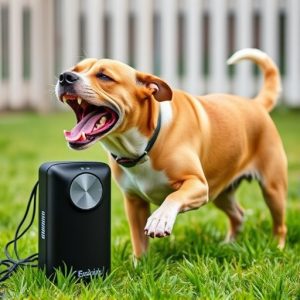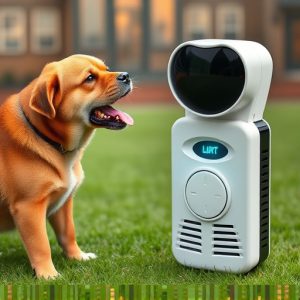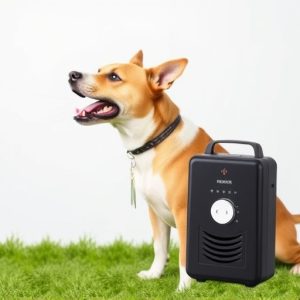Maximize Effectiveness: Choosing the Right Electronic Dog Repeller
Electronic dog repellers, using ultrasonic frequencies or vibrations, keep dogs away without harm, w…….
Electronic dog repellers, using ultrasonic frequencies or vibrations, keep dogs away without harm, with effective distances up to 100 feet (30m). Choosing the right one involves selecting the optimal frequency range (3-5 kHz) and considering factors like terrain for maximum coverage. Key features include adjustable sensitivity, remote control, and humane training methods.
“Uncover the power of electronic dog deterrents, a humane and effective solution to manage canine behavior. This comprehensive guide delves into the science behind these devices, focusing on their ability to emit specific frequencies that disrupt dogs’ communication. We explore the optimal frequency ranges for maximum impact, considering environmental factors that influence coverage distance. For pet owners and landlords, this article offers crucial insights when selecting the right dog repeller, ensuring both effectiveness and safety.”
- Understanding Dog Repeller Technology: How It Works
- Determining the Optimal Frequency Range for Maximum Effectiveness
- Factors Affecting the Coverage Distance of Electronic Dog Deterrents
- Choosing the Right Dog Repeller: Key Considerations for Pet Owners and Landlords
Understanding Dog Repeller Technology: How It Works
Dog repellers, also known as electronic dog deterrents, are innovative devices designed to keep dogs away from specific areas without causing them harm. These tools emit sounds or vibrations at specific frequencies that are unpleasant or uncomfortable for canines, encouraging them to stay clear. The technology behind these repellers has evolved significantly, becoming more effective and user-friendly over time.
The key to a dog repeller’s success lies in its frequency range. An effective electronic dog deterrent covers a distance of up to 100 feet (30 meters) and targets specific frequencies that dogs find disturbing. This technology works by detecting the presence of a canine through motion sensors or vibration, then emitting a high-frequency sound or pulse that is below the human hearing range but disrupts a dog’s sensory perception. As a result, dogs associate the area with an unpleasant experience, naturally avoiding it in the future.
Determining the Optimal Frequency Range for Maximum Effectiveness
When it comes to choosing an electronic dog repeller, understanding the optimal frequency range is key for maximum effectiveness within a specific effective distance. These devices emit sounds or vibrations at certain frequencies designed to disrupt or discourage unwanted canine behavior without causing harm. The ideal frequency should be high enough to reach the target distance but low enough to avoid excessive noise that could disturb humans or other animals.
For an electronic dog deterrent to be truly effective, it must emit within a range that resonates with dogs’ sensitive hearing. Most products cater to this need by offering adjustable frequencies, typically ranging from 3 to 5 kHz, which are known to be unpleasant for canines while remaining inaudible to humans. The right frequency ensures the repeller’s impact doesn’t fade away, making it an indispensable tool for maintaining a peaceful environment, whether in your backyard or public spaces where dogs might intrude.
Factors Affecting the Coverage Distance of Electronic Dog Deterrents
The effective distance of an electronic dog deterrent is influenced by several key factors, each playing a crucial role in determining its coverage area. Firstly, the frequency range and power output of the device are critical; higher frequencies generally have longer reach due to their ability to penetrate obstacles better. Devices operating within the 5-15 kHz range, for instance, can effectively deter dogs from a considerable distance.
Secondly, terrain and environmental conditions significantly impact coverage. Obstacles like walls, fences, trees, or buildings can reduce the signal strength, causing the effective distance to be shorter than expected. Additionally, factors such as weather conditions (rain, snow), moisture content in the air, and even the type of ground can affect signal transmission. Understanding these variables is essential for accurately assessing the potential coverage distance of an electronic dog deterrent.
Choosing the Right Dog Repeller: Key Considerations for Pet Owners and Landlords
When selecting a dog repeller, understanding its effective distance and electronic deterrent capabilities is paramount for pet owners and landlords. The key consideration isn’t just about the device’s range but also its reliability in training dogs to stay away from certain areas. An effective electronic dog deterrent should emit sounds within a range that discourages unwanted behavior without causing harm or distress.
For instance, devices with a 100-foot (approx. 30 meters) effective distance are common and suitable for indoor and outdoor use. Look for repellers that utilize ultrasonic tones or static shock as these methods are generally humane and effective in training dogs. Additionally, features like adjustable sensitivity settings and remote controls can enhance user experience, making it easier to manage and train pets.
When selecting a dog repeller, understanding its technology, frequency range, and coverage distance is key. By choosing an electronic dog deterrent with a proven effective distance and optimal frequency spectrum, you can ensure a humane and efficient solution to unwanted canine intrusions. Remember, the right device tailored to your needs will help maintain a peaceful environment for both pets and people alike.


